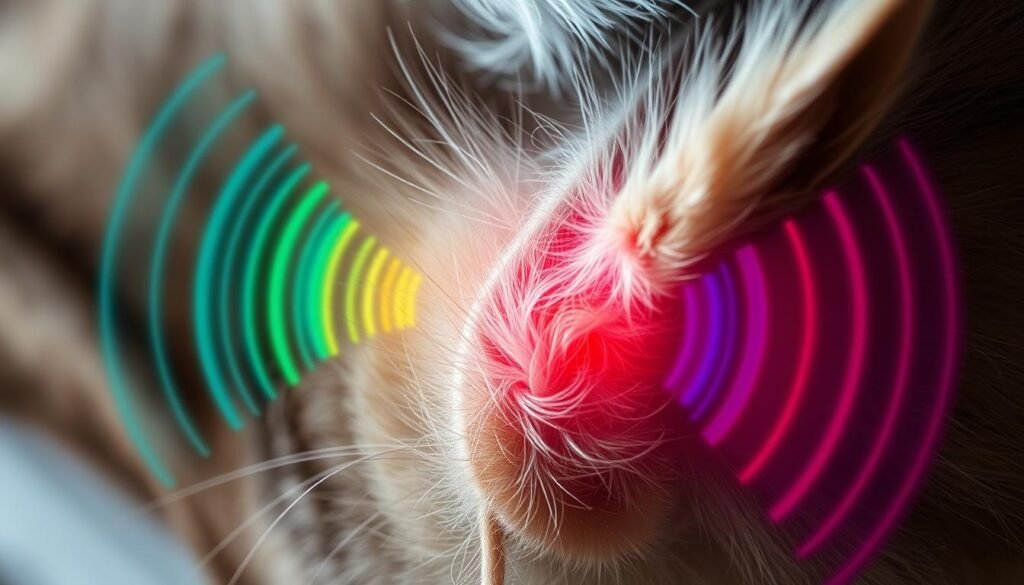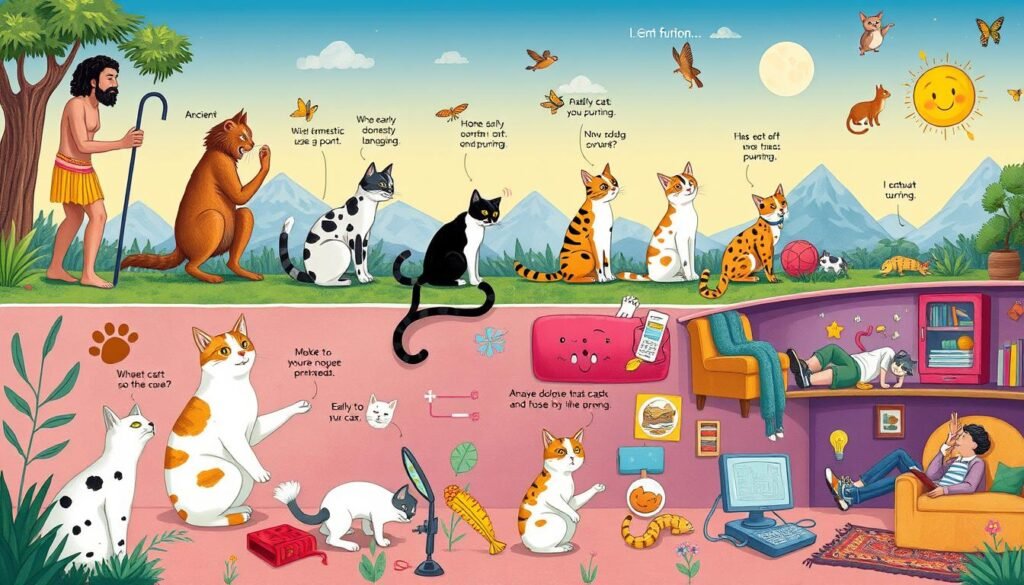Ever wonder if your cat really gets you, or just puts up with you? A study by the University of Tokyo shows cats can pick out their owner’s voice. But, they don’t seem to care about what’s being said. This makes us ask: do cats lack empathy, or just not care about talking to us?
This study gives us a fresh look at the bond between humans and cats. It helps us understand how cats process our voices. This knowledge is key to knowing how they communicate differently from us. The study’s results change how we see cat behavior and how we talk to them.
Key Takeaways
- Cats can tell their owner’s voice from a stranger’s, showing they understand and recognize.
- Even with this understanding, cats don’t seem to care about what we say, showing little interest in talking to us.
- The study’s findings are important for understanding the bond between humans and cats.
- Cats have their own way of communicating, which is different from ours. Knowing this helps us build better relationships with them.
- The study shows it’s important to consider how cats communicate when we’re with them.
- By understanding and respecting cats’ unique way of communicating, we can create more meaningful and effective relationships with them.
The Ground-Breaking University of Tokyo Study
The University of Tokyo did a study on pet cognition and animal empathy, focusing on cats. They used a special research methodology to see how cats react to human voices. They played recordings of strangers, then the cat’s owner, and another stranger.
The key findings of this study are very important for understanding cat behavior and thinking. They show how emotional and social human-cat interactions are. At the University of Tokyo, the researchers followed a strict research methodology to make sure their results were right.
This study helps us understand pet cognition and animal empathy better. It shows how complex the bond between humans and animals is. By studying how cats react to human voices, the University of Tokyo researchers have made a big impact on animal behavior and cognition.
| Research Aspect | Methodology | Findings |
|---|---|---|
| Pet Cognition | Recordings of human voices | Cats respond to owner’s voice |
| Animal Empathy | Strangers’ voices | Cats distinguish between familiar and unfamiliar voices |
The University of Tokyo study shows how important emotional and social aspects are in human-cat interactions. It gives us valuable insights into the complex bond between humans and animals.
Study: Our Cats Understand Us, But They Don’t Really Care – Breaking Down the Results
The study showed that cats can tell their owners’ voices apart. But they don’t seem to care about what we say. This makes us wonder about cat communication and pet relationships.
It turns out cats can do more than just meow. They can even understand some words and commands. But, they might not always listen to what we say.
Some key findings from the study include:
- Cats can tell their owners’ voices from strangers.
- Cats can recognize and respond to certain words and phrases, like their names and commands.
- But, they don’t seem to care about the emotional content of our voices. They might not even listen to our attempts at human-cat interaction.
The study’s results change how we see cats and their behavior. Even if they don’t always listen, cats can form strong bonds with us. By learning more about cat communication and pet relationships, we can build better connections with our feline friends.
The Science Behind Feline Hearing and Recognition
Cats have a special way to hear human voices. This lets them know who is speaking to them. Their hearing is so sharp that they can pick up sounds humans can’t.
Cats use sounds to talk to each other. They make purrs, meows, hisses, and growls. Unlike humans, cats often use body language and scent to share information.
How Cats Process Human Voices
Studies show cats can tell their owner’s voice apart. They can pick up on the unique sounds of each voice. This includes the pitch and tone.

Comparing Cat and Human Communication Systems
Cats and humans communicate differently. Humans talk a lot, while cats use sounds, body language, and scent. Knowing these differences helps us understand cats better and talk to them more effectively.
Why Your Cat Chooses to Ignore You
Cats are known for their independent nature. It’s common for them to ignore their owners sometimes. But why do they do this? Is it because they’re not interested, or is there something more to it? Understanding cat behavior and feline behavior can help you get what’s going on with your pet.
One reason your cat might ignore you is a lack of interest or attention. Cats are naturally curious. If they’re not stimulated, they might ignore you. This can happen if you’re not doing things they like, like playing or grooming.
Building a strong pet relationship takes effort from both you and your cat.
Here are some possible reasons why your cat may be ignoring you:
- Lack of interest or attention
- Overstimulation or stress
- Medical issues or discomfort
- Changes in their environment or routine

It’s key to remember that cats are unique. By understanding and meeting their individual needs, you can strengthen your bond. If your cat’s ignoring you more often, it’s a good idea to talk to a vet or animal behaviorist.
By understanding your cat’s behavior and needs, you can build a stronger, more meaningful relationship. Remember, every cat is different. With patience, love, and attention, you can help your cat feel more comfortable and engaged, reducing the chance of them ignoring you.
The Evolution of Cat-Human Communication
The way cats and humans talk to each other has changed a lot over time. This change is due to history, culture, and society. Cats have become a big part of many families. They have learned to live with humans, and humans have learned to understand them better.
It’s important to know how cats behave to talk to them better. Cats pay close attention to their surroundings. Their actions show how they feel about their world and who they meet.
Historical Perspective on Domestication
Cats were first domesticated in the Middle East about 10,000 years ago. Humans were changing from nomadic hunters to farmers. Cats were drawn to homes because of all the mice and other small animals. They became valued for their hunting and companionship.
Modern Understanding of Feline Behavior
Now, we know more about how cats behave and how they communicate with us. Studies show that cats are smart and can have complex conversations. By understanding their behavior, we can connect with them better.
Cultural Differences in Cat-Human Relationships
Culture also affects how cats and humans relate to each other. In some places, cats are seen as sacred, while in others, they are considered pests. Knowing these differences helps us communicate better with cats.
Some important things that affect how cats and humans talk include:
- Evolution: Domestication has changed how cats and humans communicate.
- Cat-human communication: Knowing how cats behave is key to good communication.
- Domestication: Cats’ behavior and social skills have been shaped by domestication.
- Feline behavior: Understanding and responding to cats is vital for a strong bond.
- Cultural differences: Culture greatly influences cat-human relationships and communication.

Signs Your Cat Is Actually Listening
Understanding cat behavior can be tricky, but there are clear signs they’re listening. Cats show they’re paying attention through ear and tail movements.
Here are some common signs your cat is listening:
- Ear positioning: If your cat’s ears are towards you, they’re likely listening.
- Tail movement: A twitching or swishing tail means they’re listening and responding.
- Body language: If your cat faces you with a relaxed body, they’re listening and feel comfortable.
Knowing these signs helps build a stronger bond with your cat. By understanding and responding to their feline behavior, you can make your relationship more loving and harmonious.
By noticing these signs and adjusting your behavior, you can deepen your connection with your cat. This will also improve your cat behavior and listening skills.
| Signs of Listening | Description |
|---|---|
| Ear Positioning | Ears facing towards the speaker |
| Tail Movement | Twitching or swishing tail |
| Body Language | Relaxed body, facing the speaker |
Building Stronger Bonds Despite Their Indifference
Cats may seem indifferent, but we can build strong bonds with them. It takes effort and understanding their behavior. Using the right communication techniques helps us connect deeply with our feline friends.
Knowing how cats communicate through body language is key. Their body language tells us a lot. For example, a twitching tail can show they’re excited or upset.
Effective Communication Techniques
Listening to a cat’s sounds is important. Meows and purrs can mean different things, like they’re hungry or happy. By listening and responding, we can have meaningful moments with our cats.
Creating Meaningful Interactions
It’s not just about food and shelter. Engaging in activities that challenge their minds and bodies is important. This could be playing with toys or using scratching posts. It helps strengthen our bond and makes our relationship more fulfilling.
Cats can form strong bonds with their humans. By understanding their body language and engaging in activities, we can deepen our connection. This creates a more harmonious home environment.
Building strong bonds with cats requires patience, understanding, and empathy. By doing so, we can have a positive and rewarding relationship with them, even if they seem indifferent at first.
| Communication Technique | Effectiveness |
|---|---|
| Vocalizations | High |
| Body Language | High |
| Playtime | Medium |
| Scratching Posts | Low |
What This Means for Cat Training and Behavior Modification
Cats can understand what we say, but they don’t always act on it. This fact is key for cat training and behavior modification. By paying attention to feline behavior and emotions, we can improve our bond with our cats.
Using positive reinforcement in cat training is very important. It rewards good behavior instead of punishing bad ones. This method not only changes behavior but also makes our relationship with our cats better.
Positive reinforcement in cat training has many benefits. For example:
- It encourages cats to do things we want, like coming when called or doing tricks.
- It helps reduce stress and anxiety in cats, which can cause bad behavior.
- It makes our pet relationships stronger by building trust and understanding.
By understanding feline behavior and emotions, we can train our cats better. This leads to stronger, more loving pet relationships.
Conclusion: Embracing Our Cats’ Unique Communication Style
Exploring cat behavior and communication shows us how vital it is to understand their way of talking. The study’s results stress the need to notice and act on our cats’ signals. This is key for good communication.
By accepting our cats’ special way of communicating, we can grow closer to them. We need to pay attention to their body language, sounds, and other non-verbal signs. Learning more about cat behavior helps us connect with them better, making our relationships more fulfilling.
It’s important to think about each cat’s unique personality and traits in our pet relationships. This way, we can adjust how we talk to them to fit their needs. As we keep learning about cat behavior and communication, we might discover even more about how they talk to us. This will make our bond with them even stronger.


[…] a snug and luxurious resting space. Whether your pet loves to stretch out or curl up, this plush cat mat ensures warmth, softness, and ultimate relaxation. It also makes an excellent Christmas gift […]